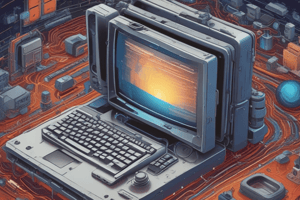Podcast
Questions and Answers
Which of the following are parts of an information system? (Select all that apply)
Which of the following are parts of an information system? (Select all that apply)
- People (correct)
- Data (correct)
- Procedures (correct)
- Internet (correct)
- Software (correct)
- Hardware (correct)
What are the two major kinds of software?
What are the two major kinds of software?
System Software and Application Software
What is the primary function of system software?
What is the primary function of system software?
To enable application software to interact with computer hardware.
Which of the following describes a supercomputer? (Select all that apply)
Which of the following describes a supercomputer? (Select all that apply)
What is RAM?
What is RAM?
Data is considered processed information.
Data is considered processed information.
The four types of computers are: Supercomputers, Mainframe Computers, Midrange Computers, and ______.
The four types of computers are: Supercomputers, Mainframe Computers, Midrange Computers, and ______.
What are the common types of personal computer hardware?
What are the common types of personal computer hardware?
Match the following types of application software with their descriptions:
Match the following types of application software with their descriptions:
What is connectivity in the context of personal computers?
What is connectivity in the context of personal computers?
The largest network in the world is called the ______.
The largest network in the world is called the ______.
Which of the following are examples of secondary storage? (Select all that apply)
Which of the following are examples of secondary storage? (Select all that apply)
Flashcards are hidden until you start studying
Study Notes
Information System Components
- Information systems consist of people, procedures, software, hardware, data, and the internet.
- People: End users who enhance productivity through personal computers.
- Procedures: Documented rules for software, hardware, and data usage.
- Software: Programs that convert raw data into meaningful information.
- Hardware: Physical devices, including smartphones and tablets, that process data for information creation.
- Data: Raw facts such as text, images, and sounds which, when processed, transform into information.
- Internet: Connects people and computers, enhancing the capabilities of information systems.
Software Types
- System Software: Background software facilitating application software interaction with hardware. Includes operating systems and utilities.
- Application Software: Directly utilized by end-users, supporting everyday tasks and specific functions.
System Software Details
- Operating Systems: Manage computer resources and user interfaces; variations include embedded OS for mobile devices and standalone OS like Windows or MacOS.
- Utilities: Specialized programs that manage computer resources; an essential example is antivirus software.
Application Software Categories
- General-purpose Applications: Commonly used across various careers, including word processors and spreadsheets.
- Specialized Applications: Focused on specific professions, including graphics and web authoring tools.
- Mobile Apps: Small programs for mobile devices, popular for social networking and entertainment.
Types of Computers
- Supercomputers: Most powerful systems for processing large datasets, e.g., weather predictions using IBM's Blue Gene.
- Mainframe Computers: High-speed machines for large organizations, often used in industries like insurance.
- Midrange Computers (Servers): More powerful than PCs but less than mainframes, designed for specific applications.
- Personal Computers (PCs): Most widely used, including desktops, laptops, tablets, and smartphones.
Personal Computer Hardware
- System Unit: Houses main electronic components; essential parts include microprocessors (data manipulation) and memory (data storage).
- Input/Output Devices: Input devices like keyboards translate human data into computer-readable form, while output devices like monitors present processed information.
- Secondary Storage: Retains data and programs even when powered off; types include hard disks, solid-state storage, and optical disks.
- Communication Devices: Enable PCs to connect and communicate with other systems; modems transform data for internet transmission.
Data and Files
- Data: Unprocessed facts that turn into information after processing. Stored data can be direct input for systems.
- Common File Types:
- Document files (word processing)
- Worksheet files (spreadsheets)
- Database files (structured data management)
- Presentation files (presentation materials)
Connectivity and Networking
- Connectivity: Enables PCs to share information with other systems, fundamentally relying on networks.
- Network: A communication system linking multiple computers.
The Internet
- The largest global network, akin to a highway connecting millions. It has significantly influenced modern computing and daily life.
WEB and Evolving Technologies
- WEB: Multimedia interface providing access to internet resources.
- Technology Impact Drivers:
- Cloud Computing: Moves computing tasks from local machines to internet-based systems.
- Wireless Communication: Transforms communication methods with increased usage of wireless devices.
- Internet of Things (IoT): Connects everyday objects to the internet, allowing them to send and receive data.
Studying That Suits You
Use AI to generate personalized quizzes and flashcards to suit your learning preferences.




